|
|
Advertisement:
|
|
AMD AthlonXP 3200+ (Barton core, 400MHz FSB) |
|
Join the community - in the OCAU Forums!
|
Effect of FSB Speed
Effect of FSB Speed:
To isolate the FSB was fairly easy. ABIT's NF7-S v2.0, like many nForce2-based motherboards, allows for multiplier adjustment of recent AthlonXP CPUs without needing to modify them. It also has a huge flexibility in setting FSB and memory speeds. This allows us to run the XP3200+ at the same core and memory speeds, while only changing the FSB. I had hoped to run the XP3200+ at 266MHz, 333MHz and 400MHz FSB's, but for some reason it refused to boot at 333x13 or 333x13.5. I realise that neither of these is exactly 2200MHz, but they would have been close enough to give us an idea, if they worked. It works at other multipliers at that FSB speed and other FSB speeds at those multipliers, but for some reason doesn't like those particular combinations. No matter, we will see the difference between 266MHz and 400MHz and can extrapolate the 333MHz speed to be somewhere approximately midway between them.
First up is SiSoft's Sandra 2003 SP1, a popular tool for benchmarking various parts of a system. We'll concentrate on the CPU and memory benchmarks.
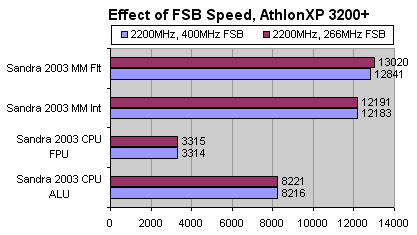
Sandra 2003's CPU-intensive benchmarks don't show much difference, which isn't too surprising given the core and cache speeds remain the same.
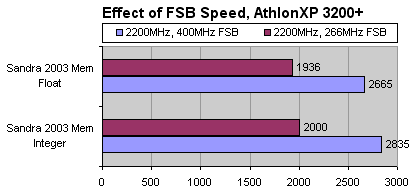
Sandra's memory bandwidth benchmark shows a marked difference. Clearly, the CPU's FSB is having a direct effect on the memory bandwidth of the system. This isn't too surprising and correlates the common "AthlonXP is FSB limited" claim. If this difference carries over to real-world usage we may see a dramatic performance increase.
Next is POVBENCH, the inbuilt benchmark of POVRAY. To quote their website: The Persistence of Vision Raytracer is a high-quality, totally free tool for creating stunning three-dimensional graphics. We used the "POV-Ray 3.5 standard benchmark v1.02", which raytraces a large image. The writers estimate this to take 45 minutes on a Pentium4 2GHz.
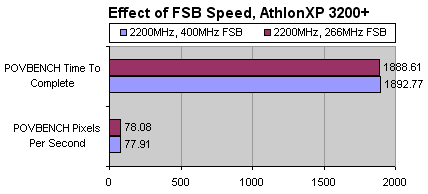
For the POVBENCH results above, bear in mind that the top graph is "less is better" while the bottom is "more is better" - not that there's a big difference either way here. This is a CPU-intensive benchmark, but I expected the memory bandwidth to play a part because when rendering a large scene you shuffle a lot of memory around. This wasn't shown in the results, with only a 4.16 second difference over 1892.77 seconds, some 31.5 minutes. For the FSB-induced difference to be a full minute, the slower benchmark would have to take over 7.5 hours to complete. This sounds more like experiment error and fluctuation rather than any real difference and certainly not one you could quanitify in terms of saved dollars for a commercial render farm.
Next is the ubiquitous 3DMark2003 (Build 320) from FutureMark. This is a DirectX 9.0a benchmark with many game-like sequences. The validity of this benchmark when comparing video cards has been under fire lately, but as we are sticking to one video card and comparing CPU settings the results should be a valid indicator of what we can expect in games.
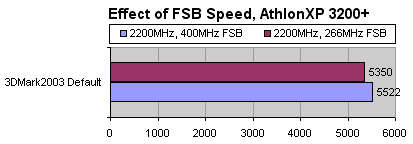
A difference of 200 or so 3DMarks is not too significant, representing a jump of only 3.2%. However, for benchmark or FPS junkies, at this high end of the scale, a couple of hundred points is certainly welcome when they are achieved "for free", by simply increasing the FSB of your CPU (which presumably you have already overclocked to the core speed limit.) Almost nobody would purchase a CPU simply for this type of jump, however.
Finally, we have Business Winstone 2002 v1.0 from VeriTest. This consists of a combination of various real-world tasks using a range of applications including OfficeXP, WinZip, Lotus Notes etc.
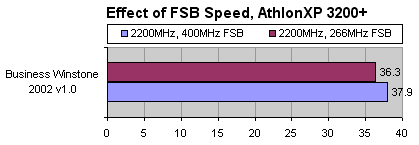
On the overall performance index returned by this benchmark we see a jump of 4.4%. Again not totally insignificant, but there's no sense of the AthlonXP streaking ahead, freed of the shackle of its until-now restrictive FSB. Given that a 400MHz FSB is clocked a full 50% faster than a 266MHz one, it's disappointing that we haven't been able to demonstrate a dramatic overall increase in any of the benchmarks.
|
|
Advertisement:
All original content copyright James Rolfe.
All rights reserved. No reproduction allowed without written permission.
Interested in advertising on OCAU? Contact us for info.
|

|


